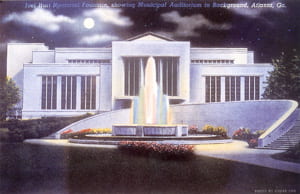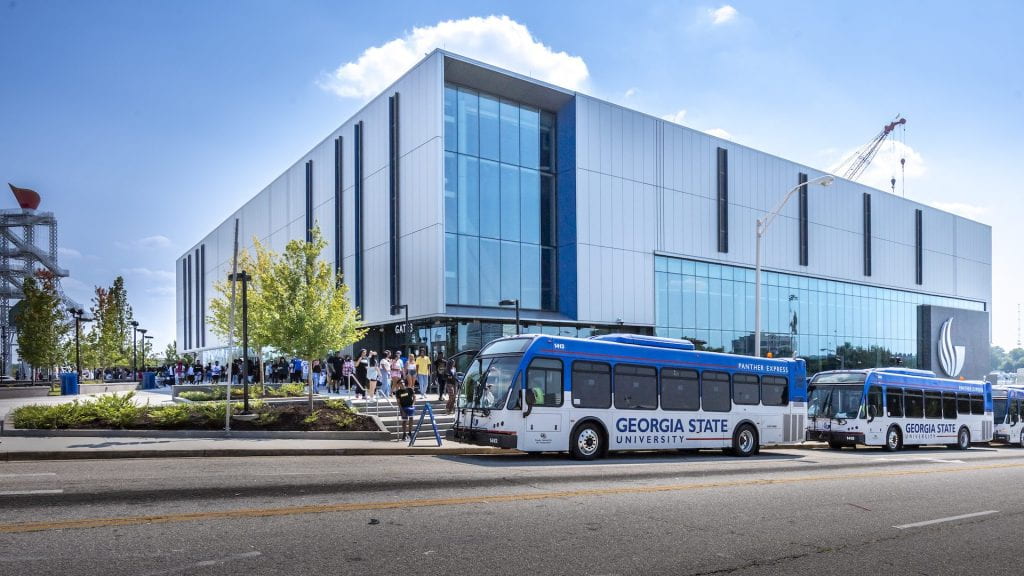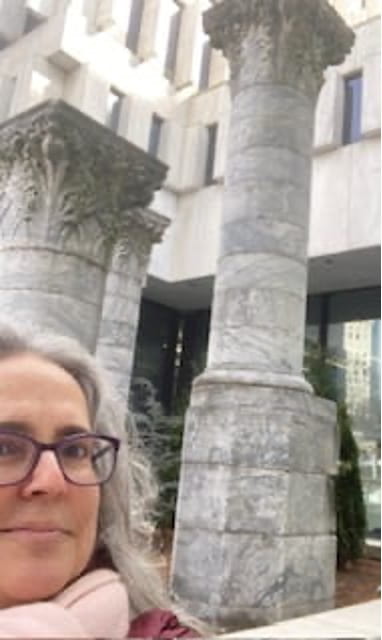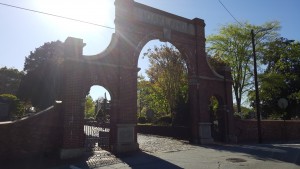
GSU students are familiar with the Atlanta Streetcar. It cuts through our university and is a part of the atmosphere of our urban downtown campus. However, few of us actually ride it. Many other Atlantans and tourists also don’t ride it, as its ridership is lackluster at best. The vehicles regularly gets stuck at intersections due to traffic congestion and are often obstructed by vehicles parking on the tracks. The trip time is sometimes no faster than walking the whole route. To top it off, the route’s maintenance facility sits underneath a highway overpass, a reminder of the car-centric city we live in. What led to the creation of the streetcar? What was it intended to do? What went wrong that led to its current state today? The answer to these questions reveals a larger pattern in Atlanta’s repeated missteps in public transit planning.
A Brief History on Streetcars in Atlanta
Atlanta has a deep streetcar history, albeit detached from the modern day one. The first rails were laid in 1871, with their vehicles being drawn by mules. A few years later, by 1890, these new streetcars were electrified. The Georgia Railway and Power Company (now known as Georgia Power) ran these routes and funded the expansion of them. These routes would be the backbone of Atlanta transit for over 80 years until being phased out by trolley-buses and later diesel-powered buses with streetcar service ending on April 10, 1949.1 From then on, Atlanta did not have a streetcar, at least until an ambitious plan in the early 2000s.

A Bold Plan for Atlanta
Seeing the success of the new streetcars built in Portland, Oregon, many cities in the United States aimed to create similar plans to redevelop their waning downtown neighborhoods and increase connectivity in the community. Atlanta would not be left behind. Peachtree Street, the famous arterial road running through Downtown Atlanta and Midtown, had the opportunity to become a more than a connecting street. It could instead serve as a unifying piece between the prospering Midtown and struggling Downtown Peachtree Street was envisioned to move partially away from being just for cars and the redevelopment along the entire road was to be accompanied by a bold new transportation project, the Atlanta Streetcar. This new streetcar was to link the large employment center of Downtown, the cultural and tourist attractions of downtown, and the various residential developments and entertainment venues in Midtown and Downtown. This project was to spur even more economic development and crucially bring development to the problematic neighborhood of Sweet Auburn, which had notably been in economic decline as the rest of the city marched onwards into the 21st century.2 This ambitious plan, obviously, was never fully realized. Today’s streetcar route only runs on Peachtree Street for a fraction of its route, does not run to Midtown, and the neighborhood of Sweet Auburn remains far from its glory days as the center of black economic prowess in the 1900s. What happened?
The Vision of What Was Meant to Be
The Atlanta Streetcar was mostly designed, built, and funded by the City of Atlanta. This would later be a major contributing factor to the issues surrounding the project as a whole. MARTA was involved in the project, but in a more advisory and oversight capacity than in direct involvement. In fact, the City of Atlanta actually operated the streetcar from its opening until 2018 when MARTA fully took over operations. The project was also partially funded by a federal transportation grant program known as TIGER, or “Transportation Investment Generating Economic Recovery. These grants were a part of the American Recovery and Reinvestment Act of 2009 in the wake of the Great Recession. The initial 2 lined project applied for funding, but did not win the first round of funding.3 In response to this, the project was cut down from a 10 mile combined North/South and East/West system to a “Phase I” 3.2 mile E/W starter line in an attempt to be more appealing in the bid process and save money.4 The decision to only do the E/W line was made despite the N/S line being a more viable transportation project with higher projected ridership figures. This may have been motivated by the idea of spurring economic development in downtown and notably the neighborhood of Sweet Auburn, which had been struggling for many years prior to the project. This was successful, and the project won funding the second round of funding in 2010 and construction began in 2012 with the route opening in late 2014 at a final cost of approximately $98 million. 5

Initial Challenges
The route even before opening has been plagued with issues. Experienced professionals were hard to find in assisting the City of Atlanta in the midst of all the streetcar projects popping up all over the nation. After opening, the situation did not improve very much. Multiple severe safety issues cropped up ranging from issues with the overhead electrical system, lack of training, and personnel issues which led to an audit by the Georgia Department of Transportation that threatened to shut down the system showing just how severe these issues were. Ridership declined over time, especially as fares were introduced (the streetcar was initially free). Fare evasion became rampant with over half of riders not paying according to the city. Documentation issues related to ridership on the streetcar even risked putting Atlanta as a whole ineligible for future federal transit grants. Most of these issues stem from the City of Atlanta’s constant mismanagement of the project, partly due to the lack of expertise as noted earlier and the priority of using the project as an economic development tool instead of a transit project as evidenced by the prioritization of building the E/W route over the N/S route. MARTA’s involvement was unclear, with management seeming to be in a state of chaos as no one seemed to know who was in charge of doing what. 6
A Small Piece of History
Beyond the planning and development of the downtown route, the streetcar’s maintenance facility tells a small bit of history on the neighborhood it runs through, Sweet Auburn. The facility sits under the overpass of I-75/85 right along the Grady Curve. While the area itself does not have much history after the highway was built, we can get a glimpse of the history of the neighborhood of Sweet Auburn. Records show that in the 1890s to the 1920s the area was mostly single family housing for colored residents, with shops lining the streets of what is now today Auburn Ave. and Edgewood Ave.7 The block would further densify into the 1930s with single family homes being demolished and replaced with apartments. Interestingly, an alley running from the middle of Bell St. to Fort St. called “Raspberry Alley” on the Sanborn fire maps split the block east to west right where the streetcars are stored today. It was this alley where a Mr. David Lee Perry lived in 1945 at 263 Raspberry Alley. Mr. Perry would be tragically murdered in 1945 on nearby Jackson St. being caught in the crossfire between four youths who had started a disturbance outside the business he was visiting.8 All these residents and businesses who lived on this block would be forced out during the construction of the downtown connector of I-75/85 in 1962.9 After this, the land under the overpass would remain vacant with it then becoming a parking lot until the streetcar project in 2013 when the maintenance and storage facility was built.10

Current Operations and Lingering Issues
MARTA fully took over streetcar operations in 2018 to consolidate light rail under a newly created division at the authority. Since then, safety has gotten better with MARTA having more experience with maintaining and staffing a transit system.11 Notably, MARTA had to send all 4 of the vehicles to the manufacturer in California in 2022 after issues were discovered with the wheels, but this was luckily discovered before any incident occurred.12 However, other issues persist such as the ridership still being lackluster, vehicles getting stuck in traffic, and as of writing mechanical issues mean that only 1 light rail vehicle operating the route with a paratransit van having to substitute as the second vehicle.
MARTA’s takeover of the streetcar system came as multiple light rail projects were planned in the city ranging from the Clifton Corridor from Lindbergh to Avondale to multiple Beltline rail projects which had been planned at the same time as the streetcar’s initial inception. Of course, as of 2025 none of the projects are under construction and are still stuck in the planning phases, with the Clifton Corridor having been downgraded from light rail transit (LRT) to bus rapid transit (BRT). Only one Beltline rail project is currently in active development, an extension of the current streetcar system eastward to the Beltline and then up it to Ponce City Market. However, recently Mayor Andre Dickens has withdrawn support for the project, saying that transit on the Beltline should focus more on lower-income areas, specifically the southwest side of the trail despite final engineering of the eastward extension due to be completed with construction expected to begin later this year. 13
A City at a Crossroads
While Mayor Dickens has an understandable cause behind his actions to serve Atlantans who desperately need better transit on the southwest side of the city, the idea of abandoning or shortening the eastward extension may lead to similar mistakes that led to the streetcar being in the less functional state that it is today. So much effort, work, and money has already been poured into the project, and it has a chance of making the streetcar a genuinely useful option for people trying to get between the busy areas of downtown to the Beltline and Ponce City Market.
Without any actual meaningful implementation of the bold projects such as Beltline rail, proposed new infill stations along the current MARTA heavy rail routes, the Clifton Corridor, and many others, Atlanta is currently stuck in a transit hell of perpetual planning and studies and constant political arguments over what should be the priority in projects. Projects like the Clifton Corridor and Beltline rail show an example of projects that should have been completed decades ago. Meanwhile, the streetcar is an example of a project that did get built, although in a reduced and watered down form. As these petty disputes continue to drag on, costs are only getting higher and traffic continues to get worse.
Conclusion: Atlanta Must Do Better
The Streetcar is not a great transit route, stemming from its flawed planning, the plan of it primarily being an economic development tool instead of a transit route, and terrible execution, as highlighted by a 93 page report by MARTA on what could be improved about the current route. Luckily it has a chance of improvement by implementing some of the items of improvement from that report such as automated switches, traffic signal priority, and a dedicated right-of-way that would accompany the planned eastern extension. Those items combined could make the streetcar more than the symbolic failure that it is in its current state. Atlanta has so many viable transit projects that could improve this city, as evidenced by the many folders I came across when researching for this project. Plans ranging from rail transit to Cobb County, a vast commuter rail system for the Atlanta area, and many extensions to the current rail system, but none of them ever saw the light of day, much less a shovel in the ground. Atlanta as a whole can, and must, do better. While other cities around the nation such as Seattle, Minneapolis, and Los Angeles continue expansion projects on their public transit, meanwhile here in the south, Atlanta has become the city where transit plans go to die. The streetcar is just one of those projects that did manage to get built after getting watered down, reduced in scope, and priorities shifted. We must learn from these past mistakes, do better, and push forward. We have to. Atlanta will only continue to grow and traffic will worsen. If Atlanta is to grow sustainably, our leaders must act on their promises and projects and not just talk about and plan our transit infrastructure. The best time to build mass transit was yesterday; the second best time is now.
Thank you to Darin Givens for helping provide articles instrumental to the completion of this project.
Sources
500.1 – Atlanta streetcar environmental assessment, 2010, Box: 59, Folder: 19. MARTA operations records, L2023-03A. Georgia State University Library Special Collections.
Almanov, Talgat, “Atlanta streetcars removed from service over safety concerns, according to MARTA”, Atlanta News First, December 8, 2022. https://www.atlantanewsfirst.com/2022/12/09/atlanta-streetcars-remove-service-over-safety-concerns-according-marta/.
Atlanta Streetcar East Extension Existing System Enhancement Report, Metropolitan Atlanta Rapid Transit Authority, November 2024, https://itsmarta.com/uploadedFiles/More/Future_and_Current_Projects/Current_Projects/MARTA_ATL_SCE_Task_2.1_Existing_System_Enhancements_Final_Report_November_2024.pdf.
Atlanta streetcar project, 2013-2014, Box: 1, Folder: 4. MARTA operations records, L2023-03A. Special Collections
Cultural Resources Survey, 500.2 – technical memorandum, Peachtree Streetcar, 2009-2010, Box: 59, Folder: 18. MARTA operations records, L2023-03A. Special Collections.
Freemark, Yonah, “For Now, Atlanta Opts to Promote Streetcar Starter Line Over Beltline”, The Transport Politic, August 23, 2010. https://www.thetransportpolitic.com/2010/08/23/for-now-atlanta-ops-to-promote-streetcar-starter-line-over-beltline/.
Green, Josh, “Atlanta Mayor Yanks Support for Eastside Beltline Streetcar”, Urbanize Atlanta, March 13, 2025, https://atlanta.urbanize.city/post/breaking-mayor-yanks-support-eastside-beltline-streetcar.
Hurley, Joseph A. and Katheryn L. Nikolich, The Sprawling of Atlanta: Visualizing Metropolitan Area Change, 1940s to Present, Georgia State University Library.
Keenan, Sean, “MARTA Officially Takes Over Atlanta Streetcar Operations, Curbed Atlanta, July 2, 2018, https://atlanta.curbed.com/2018/7/2/17525438/marta-streetcar-downtown-takeover-transit.
Leslie, Katie, “Cling Clang Clunk? Inside the Atlanta Streetcar’s First Year”, Atlanta Journal Constitution, December 19, 2015.
Project Information Package, 500.2 – technical memorandum, Peachtree Streetcar, 2009-2010, Box: 59, Folder: 18. MARTA operations records, L2023-03A. Special Collections.
Reed, Mary Beth, Historic Streetcar Systems in Georgia, Georgia Department of Transportation, January 31, 2012. https://www.dot.ga.gov/InvestSmart/Environment/CulturalResources/Pubs/GAStreetcar.pdf.
Sanborn Fire Insurance Map of Atlanta, Fulton County, GA, Volume 1 Sheet 33, 1931.
Streetcar Activation Plan, 2018, Box: 15, Folder: 9. MARTA operations records, L2023-03A. Special Collections.
Streetview of Fort Street over the years, Google Earth, earth.google.com.
“Undertaker Employee Slain on Jackston St.”, Atlanta Daily World, January 17, 1945.
Wickert, David, “Work Remains to Address Atlanta Streetcar Audit”, Atlanta Journal Constitution, March 17, 2017.
Williams, Dave, “Atlanta Loses Streetcar Grant”, Atlanta Business Chronicle, American City Business Journals, February 17, 2010. https://www.bizjournals.com/atlanta/stories/2010/02/15/daily26.html.
- Reed, Mary Beth ↩︎
- Project Information Package, 500.2 – technical memorandum, Peachtree Streetcar, Section 2 Page 5-7 ↩︎
- Williams, Dave ↩︎
- Freemark, Yonah ↩︎
- Leslie, Katie ↩︎
- Wickert, David ↩︎
- Sanborn Fire Insurance Map of Atlanta ↩︎
- “Undertaker Employee Slain on Jackston St.” ↩︎
- Hurley, Joseph A. and Katheryn L. Nikolich ↩︎
- Streetview of Fort Street over the years ↩︎
- Keenan, Sean ↩︎
- Almanov, Talgat ↩︎
- Green, Josh ↩︎










































































































